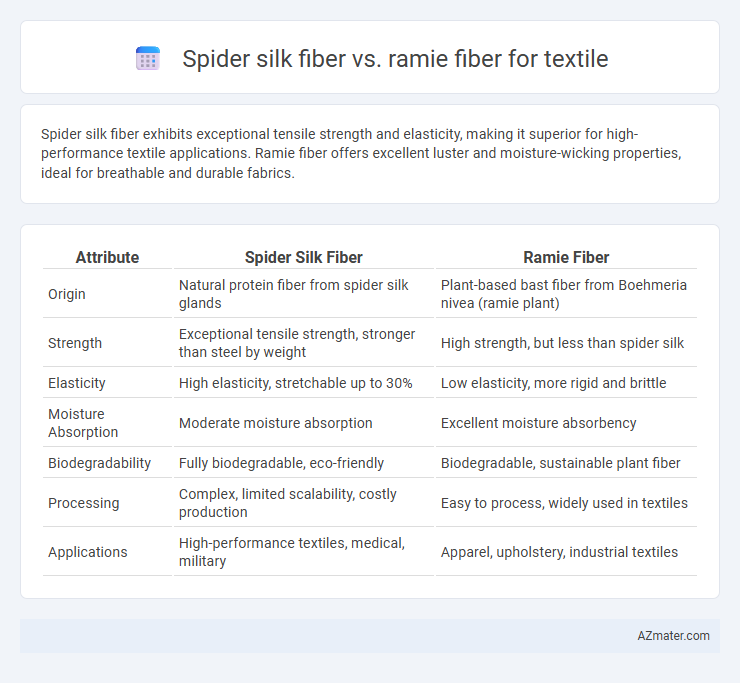Spider silk fiber exhibits exceptional tensile strength and elasticity, making it superior for high-performance textile applications. Ramie fiber offers excellent luster and moisture-wicking properties, ideal for breathable and durable fabrics.
Table of Comparison
| Attribute | Spider Silk Fiber | Ramie Fiber |
|---|---|---|
| Origin | Natural protein fiber from spider silk glands | Plant-based bast fiber from Boehmeria nivea (ramie plant) |
| Strength | Exceptional tensile strength, stronger than steel by weight | High strength, but less than spider silk |
| Elasticity | High elasticity, stretchable up to 30% | Low elasticity, more rigid and brittle |
| Moisture Absorption | Moderate moisture absorption | Excellent moisture absorbency |
| Biodegradability | Fully biodegradable, eco-friendly | Biodegradable, sustainable plant fiber |
| Processing | Complex, limited scalability, costly production | Easy to process, widely used in textiles |
| Applications | High-performance textiles, medical, military | Apparel, upholstery, industrial textiles |
Introduction to Spider Silk and Ramie Fibers
Spider silk fiber, renowned for its exceptional tensile strength, elasticity, and biocompatibility, offers a unique blend of durability and lightweight properties ideal for advanced textile applications. Ramie fiber, derived from the stalks of the Boehmeria plant, is celebrated for its natural luster, strong durability, and excellent moisture absorption, making it a sustainable choice in traditional and modern fabric manufacturing. Both fibers present distinctive benefits: spider silk excels in strength and flexibility, while ramie provides superior breathability and a glossy finish, influencing their respective uses in innovative and eco-friendly textiles.
Historical Use in Textiles
Spider silk fiber has been valued historically for its exceptional strength and elasticity, used in ancient textiles primarily within Asian cultures and occasionally for luxury garments and military applications. Ramie fiber, one of the oldest natural fibers, dates back over 6,000 years in regions like China, where it was cultivated extensively for lightweight, lustrous fabrics often blended with silk or cotton. While spider silk remained rare and expensive due to harvesting difficulties, ramie became widespread in textile production for its durability and moisture-wicking properties, influencing traditional fabric manufacturing across East Asia.
Origin and Production Methods
Spider silk fiber originates from the silk glands of spiders, mainly harvested through forced silking or genetic engineering techniques, producing a highly tensile and biodegradable material. Ramie fiber is derived from the inner bark of the Ramie plant (Boehmeria nivea) through mechanical decortication followed by degumming to remove gummy substances, resulting in a lustrous, strong textile fiber. Spider silk's production remains limited and costly due to the challenges in large-scale harvesting, whereas Ramie benefits from established agricultural cultivation and industrial processing methods.
Physical and Mechanical Properties
Spider silk fiber exhibits exceptional tensile strength and elasticity, surpassing ramie fiber, making it highly durable and flexible for textile applications. Ramie fiber, while strong due to its cellulose-rich composition, offers less elasticity but higher moisture absorbency, contributing to comfort in garments. The superior toughness and resilience of spider silk combined with its lightweight nature provide advanced performance potential compared to the relatively coarse and stiff texture of ramie fiber.
Strength and Durability Comparison
Spider silk fiber exhibits exceptional tensile strength and remarkable elasticity, surpassing many natural and synthetic fibers, including ramie. Ramie fiber, derived from the Boehmeria plant, provides high tensile strength and durability, but it lacks the extraordinary resilience and flexibility found in spider silk. In textile applications where maximum strength and durability are critical, spider silk fiber offers superior performance, especially in advanced or specialized fabrics.
Environmental Impact and Sustainability
Spider silk fiber offers exceptional biodegradability and requires significantly less water and pesticides compared to ramie fiber, which often depends on intensive chemical processing and irrigation. Ramie fiber cultivation can lead to soil depletion and water pollution due to the use of fertilizers and retting chemicals, whereas spider silk production mimics natural processes with minimal environmental footprint. The sustainability of spider silk is further enhanced by its renewable production methods, positioning it as an eco-friendly alternative to traditional ramie fiber in textile manufacturing.
Comfort and Wearability
Spider silk fiber exhibits exceptional softness and elasticity, providing superior comfort and breathability compared to ramie fiber, which tends to be coarser and less flexible. The natural moisture-wicking properties of spider silk enhance wearability by regulating temperature and reducing skin irritation, whereas ramie fiber's lower moisture absorption can result in a stiffer feel. High tensile strength and smooth texture of spider silk make it ideal for lightweight, durable textiles that maintain comfort during prolonged wear.
Applications in Modern Textiles
Spider silk fiber boasts exceptional tensile strength and elasticity, making it ideal for advanced textiles in aerospace and medical sutures. Ramie fiber, known for its luster and moisture absorbency, excels in high-end fashion fabrics and home textiles requiring durability and breathability. Both fibers contribute to sustainable textile innovation by offering natural alternatives with specific performance advantages in activewear, upholstery, and technical fabrics.
Cost and Availability
Spider silk fiber is significantly more expensive and scarce compared to ramie fiber, as large-scale production of spider silk remains technologically challenging and costly. Ramie fiber is widely available, affordable, and produced from the stalks of the Boehmeria plant, making it a cost-effective choice for textile manufacturing. The high production cost and limited availability constrain spider silk's commercial use despite its superior strength and elasticity.
Future Prospects and Innovations
Spider silk fiber exhibits remarkable tensile strength, biocompatibility, and biodegradability, positioning it as a futuristic material for sustainable and high-performance textiles. Innovations in recombinant DNA technology and bioengineering are accelerating scalable production of spider silk, enabling its integration into smart fabrics and medical textiles. Ramie fiber, known for its natural luster, durability, and antibacterial properties, continues to benefit from advancements in eco-friendly processing and blending techniques, enhancing its appeal in luxury and technical textile markets.

Infographic: Spider silk fiber vs Ramie fiber for Textile
 azmater.com
azmater.com